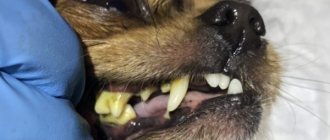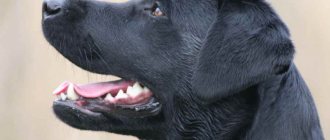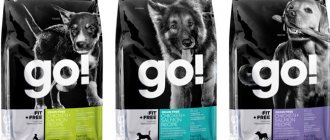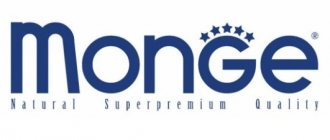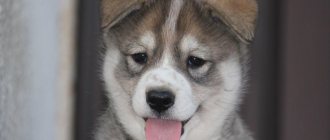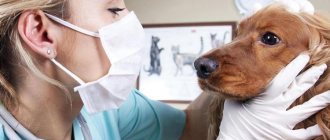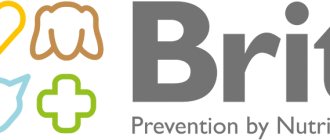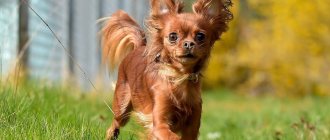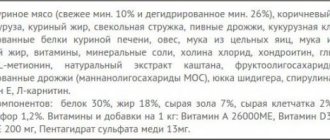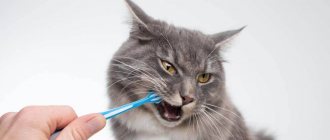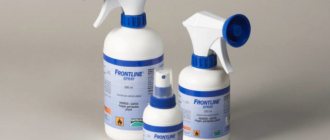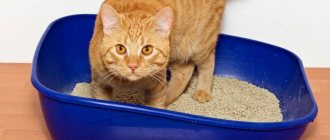Toothpaste for dogs is designed to care for the oral cavity of these cute animals.
And although in the wild dogs did and do without the procedure of external dental cleaning, scientific research in the field of veterinary medicine is increasingly signaling the need for brushing teeth to maintain dog health.
Brushing your pet's teeth every day reduces your pet's chances of developing dental disease by about 40%.
A side effect of brushing your teeth is the disappearance of an unpleasant odor, usually characteristic of animals that love to eat a lot and tasty food.
The use of toothpastes for dogs today is considered the norm, although some dog breeders are wary or at best indifferent to such innovations, considering this procedure unnecessary.
But in vain. Dental diseases can cause dogs no less pain and suffering than people...
What does daily oral hygiene do for dogs?
Animals are not able to take care of their oral cavity on their own. Over time, plaque accumulates on the teeth, and harmful microorganisms damage the tooth enamel. This leads to subsequent loss of teeth, after which the dog will be deprived of the opportunity to eat its usual food. Malfunctions in the digestive tract and premature aging of the body will begin.
Dogs need to brush their teeth just like people.
Dogs can suffer from the following dental diseases:
- caries;
- halitosis;
- periodontal disease;
- tartar.
Dog toothpaste helps combat all these dental problems.
What is tartar
Just like humans, dogs' teeth accumulate plaque over time. It is a soft growth consisting of food residues, saliva, polysaccharides and various bacteria. But over time, it hardens due to the minerals contained in saliva and turns into tartar. Typically, it consists of calcium phosphate and calcium carbonate, as well as organic matter and microorganisms.
Composition selection
It is absolutely unacceptable to use human toothpastes to sanitize a dog’s mouth. The fluorine and xylitol they contain cause intoxication and allergic reactions in pets.
Reusable diapers for dogs, as well as disposable ones
However, even when choosing dog toothpaste, you should definitely consult a doctor at a veterinary clinic. You should also carefully examine the ingredients in your cleaning product.
Important! People rinse their mouths after brushing their teeth, but dogs do not need to.
Causes
In the wild, the ancestors of our four-legged friends cleaned their teeth naturally by chewing on the bones of their prey. A domestic dog that eats soft food does not need to chew solid food and does not undergo mechanical cleaning of its teeth, which increases the risk of tartar formation.
Oral hygiene, or rather the lack thereof, is of great importance. It is extremely important to use preventatives even if your dog is eating solid (dry) food.
There is also a genetic predisposition to the development of tartar. In small dogs and brachycephalics, diseases of the oral cavity are much more common, this is due to the proximity of the teeth to each other.
Risk group:
- dwarf and small dog breeds;
- brachycephals;
- dogs whose diet mainly consists of soft food;
- dogs over 3 years old.
How to prepare your dog for teeth brushing
Nicknames for dogs for boys, huskies, and also for girls
It is necessary to prepare the following tools:
- toothpaste and brush;
- a bowl of water;
- goodies;
- towel.
The animal is called and caressed. They let him sniff the prepared instruments. Then they lay a towel on the table and sit the pet on it. It is better for small breed dogs to brush their teeth while lying down.
The pet is fixed. With one hand they take it by the head, lifting the upper lip near the nose, little by little going deeper towards the cheeks in the process of brushing the teeth. With the other hand, take a toothbrush, lightly moisten it with water and apply a little toothpaste.
Necessity of the procedure
Caring for your pet's teeth is important not only for the pet's attractive appearance and eliminating unpleasant odor from the mouth. A dental procedure is necessary to prevent dangerous oral diseases. The most common problems include:
- caries;
- periodontal disease;
- stomatitis;
- gingivitis;
- abscesses.
If left untreated, pathologies become chronic and seriously affect the functioning of the entire body: from the cardiovascular system to general immunity.
Along with the lack of hygiene procedures, the condition of the canines is adversely affected by low-quality food. If there is not enough calcium and phosphorus in them, the enamel will become thinner.
There are breeds that are more prone to canine problems than others. These representatives include cocker spaniels, terriers and poodles. Dobermans, setters and sharpeis boast strong jaws.
How to properly brush your dog's teeth
The dog should be accustomed to sanitation of the oral cavity gradually. It's better to do this from childhood. First, let the pet lick the brush, then try the paste. Then they try to brush their teeth - at first a little while the puppy allows it, and over time, more and more.
First you need to clean your back teeth
Any dog will perceive mouth sanitation as not a pleasant procedure. For this reason, while brushing teeth, one of the household members should definitely try to calm the dog down.
The distant teeth are cleaned first, since pulling back the lip will be less unpleasant for the pet, unlike lifting the nose. Initially, only the outside of the teeth is cleaned. When the pet gets used to regular sanitation of the mouth cavity, it is permissible to begin cleaning the plaque that accumulates on the inside of the teeth.
Important! After completing the procedure, you need to praise the animal every time and, if possible, reward it with treats.
How often?
Fortunately, this procedure does not need to be carried out every day, 2 times a week is enough , on other days the dog is given bones. Approximately 10 minutes are allotted for cleaning; the animal (and you) will not tolerate any more.
The question of how often puppies need to brush their teeth is ambiguous: babies do not need brushing at all, so the frequency of the procedure depends only on the animal’s learning ability.
Important : if your dog’s gums bleed after brushing, you need to wipe them with chlorhexidine . If the gums are inflamed, stop brushing the teeth for a while, and the dog should be shown to a specialist.
Top brands
Below are several brands of dog toothpastes that have the most positive reviews on dog owner forums.
Dental Fresh / Liquid toothbrush Dental Fresh
The liquid toothbrush actively fights halitosis and also has a slight whitening effect. Dental Fresh is available in the form of a mouth rinse and spray.
A teaspoon of rinse aid is diluted with 250-300 ml of drinking water.
Important! Some pets refuse to drink this water because of the small amount of menthol contained in the rinse.
Dental Fresh dog teeth spray is applied directly into your pet's mouth twice a day. A liquid toothbrush is used for a course of 4 weeks with breaks of 4 months.
Dental Fresh
Beaphar Dog A Dent
Beaphar Dog A Dent fights several dental problems at once:
- bacteria;
- pigmentation on teeth;
- stale breath.
This paste does not foam and is very economical to use.
8 in 1 DDS Dental Breath Tabs / Tablets for fresh breath
Representatives of some dog breeds can sometimes experience downright bad breath. A good alternative to toothpaste for such pets would be tablets for fresh breath. They do not cause allergic reactions and are completely harmless to the dog’s body.
Dental Breath Tabs should be given to your dog 2-3 times a day. By the end of the first day of treatment, dog owners note a significant reduction in the unpleasant odor from the animal’s mouth.
Important! Dental Breath Tabs is a remedy with a short-term effect, akin to the well-known human Orbit or Dirol.
Platinum
An excellent toothpaste for dogs against tartar is OralClean + Care from Platinum. In addition, this cleanser is effective against gum inflammation and bad breath.
OralClean + Care produces products that are absolutely harmless to the body of pets. It is completely safe to swallow when used.
Cliny
Gel for dogs for cleaning teeth Cliny with silver ions from the German company Neoterica helps to cope with a number of dental problems:
- plaque;
- halitosis;
- yellowness of teeth;
- inflammation of the gums;
- periodontal disease;
- stomatitis;
- tartar.
The above gel for cleaning teeth in dogs can be used without a brush, since the Cliny product disperses well with saliva.
Important! You should sanitize your dog's mouth with dental gel for dogs 2-3 times a week.
Tropiclean
Tropiclean dental gel for dogs perfectly removes tartar and also solves the problem of unpleasant odor from the mouth. Despite the sharp minty smell, Tropiclin completely lacks any taste.
Gel Tropiclean
When lifting your dog's upper lip, you should place just a couple of drops of cleaning agent on the far teeth. The manufacturers of Tropiclin advise not allowing your dog to eat or drink for half an hour before and after using the gel.
This dental cleaner can be used daily for a month, after that only once every 3 days to consolidate the results.
Le Artis - wet wipes
The hypoallergenic impregnating product is made specifically as a hygiene product for pets. Le Artis is a good remedy in the fight against the following dental ailments:
- caries;
- plaque;
- yellowness of enamel;
- halitosis;
- tartar.
Wet wipes can be used once a week if you cannot brush your teeth.
Hartz Dentist's Best Toothpaste / Vanilla and Mint Flavor
Advantages of Hartz paste:
- safe for dogs;
- effective in the fight against halitosis;
- has a good antibacterial effect;
- fights tartar.
It is enough to use once every three days.
Symptoms, types, consequences of tartar
The presence of tartar in dogs can be detected with the naked eye by examining the dog's mouth. If you notice yellowish deposits on your teeth and an unpleasant odor from your mouth, know that this is it. In advanced cases, the stone on the teeth becomes darker in color and increases in size. The dog may also notice reddening and bleeding of the gums, and the pet may be reluctant to eat food, especially solid food.
Depending on the location of the stone on the teeth, they are divided into supragingival and subgingival.
We can see supragingival stone when examining the oral cavity. It forms on the surface of the tooth and borders the gum. It looks like a rough gray or yellow or yellow-brown hard growth. Such a stone can damage the mucous membranes of the cheeks and lips, which can subsequently lead to their inflammation.
Subgingival stone is located under the gums, on the root of the tooth and can only slightly protrude onto the crown. It has a dark green color and is much harder than supragingival. If this stone is of significant size, then it detaches the edge of the gum from the tooth, causing gum inflammation. This can cause infections to penetrate inside the tooth.
Most often, these two types of tartar occur simultaneously. If the oral cavity is not sanitized in a timely manner, then for the most part this leads to severe inflammation of not only soft but also bone tissues, up to and including serious dental diseases.
Making toothpaste for dogs at home
You can make your own dog toothpaste. To do this, water and ordinary clay are mixed in equal proportions. Add a tablespoon of honey to 200 g of the mixture as a preservative. If your dog is allergic to honey, 5 drops of sage oil will be suitable as a preservative.
Homemade toothpaste for dogs.
If there are problems with yellow teeth, the mixture is supplemented with 1 tsp. table sea salt. The above product can be stored for up to 2 weeks.
Important! The procedure should be carried out especially carefully so as not to damage the animal’s gums.
What can you use instead of pasta?
If you don’t have a special toothpaste on hand, you can use other products. Please note that you cannot use tooth powder or baking soda. Regular toothpaste is too aggressive for an animal, even for children.
For such purposes, you can use diluted hydrogen peroxide. Activated carbon, chlorhexidine, tomato paste. To do this, wrap the finger in a bandage, soak it in the product and clean the teeth.
Choosing a toothbrush for dogs
It is unacceptable to use human toothbrushes to clean dogs' teeth, since these products have an insufficient angle of inclination and a handle that is too short. This is especially true for small breeds.
In pet stores you can find a wide variety of dog toothbrushes:
- silicone fingertips;
- toy-shaped sponges made from natural fibers;
- regular brushes with extended handles;
- three-sided models that allow you to brush your tooth from three sides at once.
It is better to choose products from well-known brands that have positive reviews on dog breeders forums: for example, the American DDS, the German Hartz or the domestic Triol. Such products are of sufficient length, gently clean your pet’s teeth and gums, and their bristles do not fall out over time.
Dogs need a special toothbrush
The service life of dog toothbrushes is 3-4 months. This cleaning product will also have to be changed to a new one after the pet has had an infection.
Important! After each use, wash the toothbrush well with running water and store it in a separate glass to dry.
When purchasing a puppy from breeders, among other things, it is recommended to consult with a veterinarian regarding all measures for cleaning dog teeth. You should find out in advance which toothpastes are acceptable to use, which brushes are best to choose, and how to properly brush your dog’s teeth.
Treatment
It is impossible to remove tartar at home. The procedure for removing tartar is carried out only in a veterinary clinic under general anesthesia. Anesthesia is necessary for a thorough examination and cleaning of teeth, and no dog will allow any manipulation in its mouth.
In veterinary dentistry, two methods are used to remove tartar in dogs: mechanical and ultrasonic.
Mechanical removal
It is carried out with special dental instruments. This method has several disadvantages - the possibility of damage to the gums and teeth when pressing hard on the instrument, as well as the inability to remove plaque.
Ultrasound method
It is more popular, effective and painless. This procedure is carried out using a special apparatus - a scaler. Due to ultrasound, tartar is destroyed and peeled off from the tooth. The only drawback of this method is the difficulty of removing subgingival stone.
First cleaning
It is necessary to accustom your dog to brushing its teeth from puppyhood. However, adults also get used to this dental procedure. The main thing is to act patiently and without unpleasant pressure.
Preparing the animal
For real, using a brush and paste, the dog’s fangs should be treated after 6-7 months. Then the milk teeth are replaced with permanent ones, and they are the ones that require special care and attention. Before this, I use gauze and broth to get used to it (see below).
You should not perform manipulations on a full stomach, because a puppy or an adult dog may vomit. Veterinarians recommend starting in the evening, when the dog has walked, eaten and is ready to rest.
It is important to be persistent and not stop trying if you fail. If a puppy or adult dog does not resist and endures, then after a successful process you need to praise him properly.
How to teach a dog to brush its teeth step by step
During the first cleanings, it is important to remain calm for both the owner and the pet. You should not use violence or shout at the animal, so as not to develop a negative reflex at the sight of a brush and toothpaste.
With shy individuals you need to work very gently and affectionately, and with those prone to aggression or self-indulgence - strictly but kindly. It is important to show the dog that the procedure cannot be avoided - and there is nothing wrong with it.
As soon as the pet has become comfortable in your home, start touching its teeth - carefully touch the protruding fangs, and when the dog breathes with its mouth open, you can lightly touch the tongue. A little later, allow yourself to open your mouth with your hands. At the same time, do not cause discomfort to your pet.
Over time, the animal gets used to the fact that the owner can touch its mouth, tongue and gums. Then you can begin direct training.
For the first cleaning, it is best to proceed as follows:
- Prepare broth from lean meats or take your favorite pate.
- Wrap your finger in several layers of gauze or bandage.
- Dip your finger into the broth.
- Run it along the jaw: along the lips, near teeth, if the dog is calm - along the gums or tongue.
- Gradually, the intervention is made longer and the penetration deeper. At the end of the training, you need to reach the farthest molars with your finger.
Gradually, the broth is replaced with a special paste, and the gauze is replaced with a brush. The procedure of accustoming to new means and instruments also takes some time. Here you need to monitor your pet’s reaction and, if they do not accept them, choose others. Then the pet will not experience irritation and will quickly get used to the new sensations.
Introduction to brush and paste
After your four-legged friend has gotten used to cleaning his mouth with gauze moistened with broth, it’s time to introduce him to the brush and paste. They should be used after the animal is 6-8 months old. For a small dog, a small brush with soft bristles is suitable. Gradually the brush is replaced with harder analogues.
Each new brush should not be used immediately, but should be introduced to the dog first. Let the animal sniff the tool, touch it with its paw, or even bite it lightly. If things don't go well, you can soak the brush in the broth.
Before using the paste, you must show it to your pet. He must get used to the smell of the product. The dog can even taste it - this will make it easier to get used to and will simplify care in the future.
Alternative options
If the animal flatly refuses to accept the procedure or is too aggressive, do not despair. The owner can always ask the veterinarian or veterinary pharmacy employee what else can be used to brush the dog’s teeth. Alternative options work well both as an addition and as a primary care product.
Gnawing toys
There is a real sea of toothpick toys in pet stores and online stores. These oral appliances are made from edible or inedible materials that are safe for the health of the animal.
Their use helps eliminate plaque and keeps the oral cavity in good condition. This is especially important for breeds that participate in hunting and must have strong, strong jaws.
Special dice
Four-legged friends love to chew bones. Natural raw bones are suitable as an alternative to synthetic bones. The main thing is not to give tubular bones, which can harm your pet.
Special sticks and bones are not only effective for removing plaque, but also beneficial for the animal’s body. Manufacturers enrich their composition with vitamin and mineral supplements that have a good effect on the condition of the mouth and gastrointestinal tract.
Chewable treats
Chewable treats have the same effect as bones. They consist of ingredients that strengthen the dog's chewing muscles and help cleanse the mouth.
When choosing treats to chew, you need to pay attention to their composition. They must not contain artificial flavors or synthetic flavorings. An excellent option would be dried tripe or other dried/dried offal.
Dry food
Feeding dry granules is a good prevention of stone and plaque formation. It has been proven that the introduction of this type of food into the diet speeds up the cleaning of the oral cavity by 2-3 times.
A high-quality dry product is enriched with vitamins and minerals, which have an additional positive effect on the condition of the enamel.
Additives to water
To prevent the appearance of plaque and stone, you can use special additives in water. They are produced in the form of gels, solutions or tablets. Purchase supplements from a veterinary pharmacy and use them only strictly according to the instructions. Thanks to these products, the dog freshens his breath and cleanses the surface of the enamel from plaque.
Procedure algorithm
The procedure should be carried out within 2-3 minutes. A four-legged friend should not experience discomfort - only in this case will he be favorable towards this process. If the owner did not have time to treat the entire mouth, then it is better to do it next time or at least in a few hours.
There is a clear algorithm for how to brush your dog’s teeth at home. The action steps are as follows:
- Let the dog smell the toothpaste and brush. If he is well acquainted with these means, it is enough to simply show them to your pet.
- Lift your pet's lip and run your finger along the gums.
- Clean the outer side of the fangs first, gradually moving the brush in one direction. You need to move from the junction of the fang with the gum to its pointed end. You shouldn't press too hard.
- Press on the mouth so that the pet opens its mouth.
- Treat the inside.
Pets that eat dry food clean the plaque from the inside themselves, so this cleaning step can be skipped. After the successful completion of the process, you should encourage the pet, pet and praise it.
